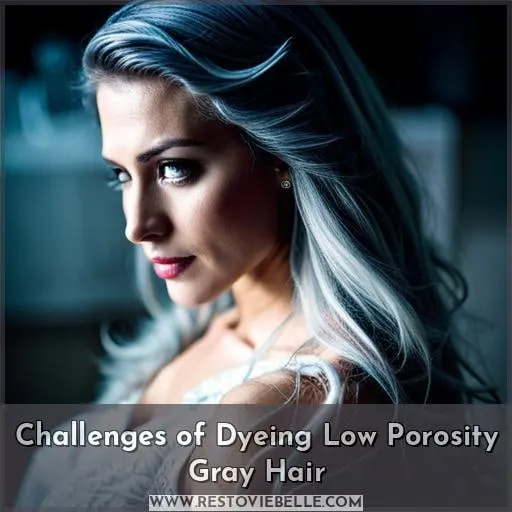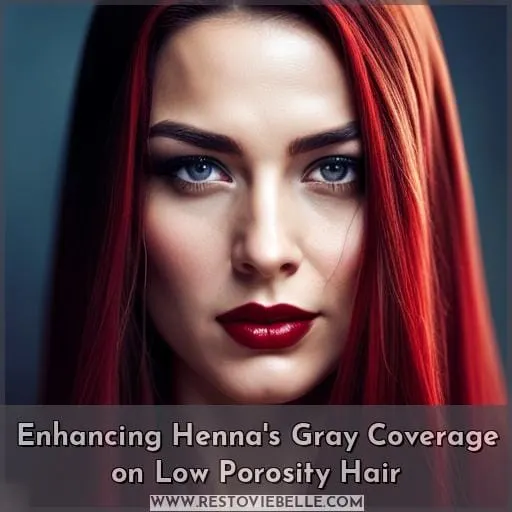This site is supported by our readers. We may earn a commission, at no cost to you, if you purchase through links.
 They say necessity is the mother of invention. As you can imagine, when it comes to covering grays on low porosity hair that’s resistant to moisture and color, it takes a special kind of ingenuity. But with the right strategies in place – like using fresh henna powder mixed with an acidic liquid – henna can absolutely cover grays on low porosity hair.
They say necessity is the mother of invention. As you can imagine, when it comes to covering grays on low porosity hair that’s resistant to moisture and color, it takes a special kind of ingenuity. But with the right strategies in place – like using fresh henna powder mixed with an acidic liquid – henna can absolutely cover grays on low porosity hair.
Absolutely! In this article, we’ll look at some expert tips for gray coverage while prioritizing healthy strands. We’ll also explore other natural dyeing options as well as discuss different types of henna and how best to apply them onto your mane without risking dryness or breakage.
Get ready to learn everything there is about coloring gray hair naturally!
Table Of Contents
- Key Takeaways
- Challenges of Dyeing Low Porosity Gray Hair
- Enhancing Henna’s Gray Coverage on Low Porosity Hair
- Prioritizing Hair Health and Quality Henna
- Understanding Different Types of Henna
- Tips for Applying Henna Hair Color on Low Porosity Hair
- Exploring Other Hair Color Options for Gray Coverage
- Conclusion
Key Takeaways
- Necessity drives invention, such as covering grays on low porosity hair.
- Strategies for gray coverage: fresh henna + acidic liquid (like lemon juice).
- Natural solutions like henna work on low porosity grays.
- Clarifying shampoos, ACV rinses, and demi-permanent colors can be used as alternatives.
Challenges of Dyeing Low Porosity Gray Hair
Dyeing gray hair can be difficult due to the low porosity of the strands, as well as its lack of natural pigment. Heat styling can also make the hair more resistant to color absorption, further complicating things.
Understanding these challenges is key to achieving successful results when dyeing your gray locks with henna or other products.
Resistance to Moisture and Color
You may find it difficult to achieve the desired results with dyeing due to low porosity hair‘s resistance to moisture and color uptake. To counteract this, you must focus on maintaining a balanced level of hydration in your hair and using gray blending techniques or products that help retain color.
Henna can also be used for gray coverage; however, its effectiveness depends on the type and quality of your hair. It is recommended to use fresh organic henna powder. As an added measure before applying henna, consider clarifying your strands with shampoo or ACV for better pigment retention.
With these strategies in place, combined with regular hydration maintenance routines, covering grays will become a much easier process!
Lack of Natural Pigment in Gray Hair
Drawing attention to the fact that gray hair lacks natural pigmentation, it can be difficult for color treatments to take hold and produce desired results. Porosity effects must also be taken into account when considering gray coverage methods, as low porosity strands may not absorb any dye whatsoever.
Natural solutions such as henna have been used successfully on some cases of low porosity grays, but should only be used if you’re comfortable with the possible commitment involved in using this product.
Other options include clarifying shampoos, ACV rinses, or demi-permanent colors, which deposit color without fully penetrating the hair shaft. These require a bit more maintenance than henna; however, they do provide more control over your end result.
Impact of Heat Styling
Heat styling can make the hair more resistant to dye, making it harder for you to get full gray coverage. To prevent heat damage and maximize your henna’s potential, use a heat protectant product every time you style.
Apply low-heat treatments such as air drying or using rollers rather than heated tools.
Enhancing Henna’s Gray Coverage on Low Porosity Hair
Enhancing henna’s gray coverage on low porosity hair requires the use of fresh and organic henna powder mixed with acidic liquids such as lemon juice or apple cider vinegar, along with an extended application time for better results.
This not only ensures that your hair is being treated in a natural way but also increases the effectiveness of coloring grays on low porosity locks.
Using Fresh and Organic Henna Powder
Discover how to use fresh and organic henna powder to take your gray coverage game up a notch! To cover grays on low porosity hair, it’s crucial to follow the right preparation techniques. Organic henna offers benefits such as sealing in moisture, adding strength, and enhancing shine.
For the application process, mix the henna powder with an acidic liquid like lemon juice or ACV for better results. It’s also recommended to leave the mixture on for an extended period of time, ideally 4-6 hours, before rinsing with warm water only (avoid using shampoo).
To overcome the challenges of dyeing low porosity gray hair, start by clarifying the hair first. Then, use color depositing products along with a high-volume developer if necessary. However, keep in mind the potential side effects of frequent use, such as dryness and breakage.
Therefore, it’s important to prioritize the health of your hair over achieving desired color results.
Mixing Henna With Acidic Liquids (Lemon Juice, ACV)
Mixing a fresh and organic henna powder with acidic liquids like lemon juice or apple cider vinegar can give you the gray coverage you’ve been searching for. Alternative acid options, such as rice wine vinegar, white distilled vinegar, or even yogurt, may be used instead of ACV.
Adding an acidic liquid to your henna mix helps open up the cuticles on low porosity hair, allowing it to absorb color better and provide excellent gray coverage.
For optimal absorption into strands of hair, it is recommended to use a pH 5-6 liquid when mixing henna with an acidic substance. When applying lemon juice or other alternatives to your mixture, keep in mind that they will make the product more runny than usual, which can cause some messiness during application time.
With patience and perseverance using this technique, you’ll be able to achieve great results, whether you are looking to cover grays or completely change up your look!
Extended Application Time for Better Results
For optimal gray coverage, leave the henna mix on for four to six hours. Henna is an effective natural solution for low porosity hair looking to cover grays, but challenges arise when trying to dye this type of hair due to its resistance.
Prolonged coloring time helps break through these barriers and allows the henna mix to penetrate deeper into strands, resulting in better coverage. To ensure successful application, start with clean, product-free hair and section it off before applying a mixture of fresh organic henna powder blended with acidic liquids like lemon juice or ACV.
The higher pH level will help open up cuticles so that color can settle more deeply within them.
Lastly, remember not to use high-volume developers as they can damage your tresses!
Prioritizing Hair Health and Quality Henna
Considering using henna to cover gray hair? It’s important to be aware of the potential risks first. Henna, while a natural and effective option for coloring grays, may cause dryness or breakage when used too frequently, as well as allergic reactions in some cases.
Disadvantages of Using Henna for Hair
Before deciding to use henna for your hair, be aware of the potential disadvantages that come with it. Henna creates a permanent stain on the hair and carries risks such as drying effects or allergic reactions.
Additionally, the longevity of the color is unpredictable, which could require more frequent applications. To avoid these issues, consider application tips like using fresh organic powder mixed with an acidic liquid (such as lemon juice or ACV).
Furthermore, choose a product free from harsh chemicals to prioritize hair health and achieve quality results.
Risk of Dryness and Breakage With Frequent Use
Frequent use of henna on your hair can cause dryness and breakage, so be sure to consider the commitment before deciding if it’s right for you. To prevent breakage, maintain a healthy moisture balance with deep conditioning treatments like hydrating masks or oil-based serums.
Allergic concerns are possible as well; always do a patch test before using any product containing henna on low porosity hair.
Potential Allergic Reactions
Be aware of the potential for allergic reactions when using henna, such as itching and swelling. Although rare, if you have skin sensitivity to certain ingredients in henna, it can cause a reaction on your scalp or face.
If you’re new to this practice, take precautionary steps. Test a small patch of skin before use and research the type and quality of the product being used. Look out for signs like redness, irritation, or inflammation. Knowing how to identify allergies is essential when dyeing low porosity gray hair with henna.
It’s important that health comes first! Keep an eye out for any negative effects during application time and be prepared with remedies should anything arise.
Understanding Different Types of Henna
If you’re exploring henna for gray hair, it’s important to understand the different types of henna available. Neutral cassia adds a golden hue to light hair and acts as a deep conditioner on dark hair.
Black indigo is used in combination with other ingredients like amla or lemon juice for deeper color penetration and more coverage of grays. Reddish/copper henna can be used alone or combined with cassia powder to provide subtle highlights while conditioning your scalp and strands.
Neutral Cassia and Its Benefits
Discovering neutral cassia can be a game-changer for natural gray-haired folks, as its golden hue adds an unprecedented level of shine that could make you feel like royalty! This type of henna works best on low porosity hair and helps to strengthen it while also providing coverage for grays.
It is important to note the difference between using cassia versus regular henna when applying on low porosity hair, as this will affect results. Neutral Cassia has many benefits such as increased shine, improved moisture retention in the cuticle layer, and conditioning properties that help reduce breakage too.
With these factors taken into account when selecting a product for covering grays or strengthening your locks, you’ll have healthier-looking hair before long!
Black Indigo and Its Effects
Try out black indigo to add depth and dimension to your hair while covering those pesky grays! When applied, it can darken the color of henna and cover gray hairs. Mixing in an acid base like lemon juice or a pH 5-6 liquid will help with absorption on low porosity hair.
Black indigo fades faster than other herbal remedies, so you’ll need frequent touchups for maintenance. It also works well when combined with cassia’s golden hue for lightening effects or added nourishment on darker locks.
Use this natural remedy sparingly; too much could lead to dryness and breakage over time.
Reddish/Copper Henna and Its Uses
Unlock your hair’s hidden potential with reddish/copper henna, a natural remedy that can add brilliant hues and shine like never before! Red henna creates warm copper tones on light to medium brown hair.
With the right application techniques, this type of henna can give you a luminous look that radiates natural healthiness. To get optimal results for different types of low porosity gray hairs, mix fresh organic red henna powder with acidic liquids like lemon juice or apple cider vinegar for longer-lasting color and hydration.
Ingredients such as honey and coconut milk can help keep your hair conditioned after rinsing out.
Achieving an auburn hue requires strategic sectioning off areas when applying the product – but it is well worth it for lush locks full of radiant shine!
Tips for Applying Henna Hair Color on Low Porosity Hair
It’s important to take certain steps when applying henna hair color on low porosity hair in order for it to be effective. First, make sure your hair is clean and free from any product residue. Then, mix the henna with an acidic liquid like lemon juice or apple cider vinegar (ACV) for a pH level of 5-6.
Afterwards, section your hair so that the application can be thorough and leave it on for 4-6 hours before rinsing with warm water without shampoo or conditioner.
Starting With Clean, Product-Free Hair
Before applying henna to your hair, make sure it’s free of any product residue to ensure the best results. Preparing for a successful coloring session involves understanding porosity considerations and moisture locks.
To start with clean, product-free hair, clarify using shampoo or ACV. Use heat styling sparingly and avoid products that contain waxes or silicones.
Apply an acidic mix of henna powder mixed with lemon juice or apple cider vinegar (ACV) onto your scalp, section by section.
Mixing Henna With PH 5-6 Liquid (Lemon Juice, ACV)
Mixing your chosen acidic liquid with henna powder is the key to an effective gray hair coverage solution. Lemon juice or apple cider vinegar can be used in combination with henna powder to adjust pH levels and ensure optimal porosity and color depth.
Both liquids are acidic but have different ratios of acidity, which may affect the overall outcome of results on low porosity hair. Lemon juice, with its higher pH, is best for lighter shades, while apple cider vinegar is better suited for deeper colors when covering grays on low porosity hair.
Experimentation can help determine what works best for you!
Sectioning Hair for Thorough Application
For even coverage, it’s important to section your hair before applying henna. Divide the head into four sections: front, back, left, and right sides. Clip each area off separately for a more strategic division of the strands when dyeing with henna.
Thorough application requires using a brush or comb to part each layer into small subsections. This allows you to evenly distribute color across all areas of low porosity hair without missing any gray spots.
It’s also beneficial to twist smaller locks around your fingers while raking through with the product for better control and saturation during the application process.
Leaving Henna on for 4-6 Hours
After sectioning your hair for even coverage, let the henna soak in and do its job by leaving it on for 4-6 hours – a small sacrifice that’ll bring great reward!
The effectiveness of covering gray hairs with henna depends on application techniques, the impact of porosity, and the variant of henna used. Optimal duration also plays an important role in achieving desired results. Leaving a protein treatment before applying henna can be beneficial for low porosity hair when trying to effectively cover grays.
For better outcomes, keep it on between 4-6 hours. Keeping it on for longer or shorter periods could be detrimental to your overall look.
Rinsing With Warm Water (Avoiding Shampoo/Conditioner)
Once you’ve left the henna on your hair for 4-6 hours, it’s time to rinse! Using warm water instead of shampoo and conditioner has its benefits. It helps avoid chemicals that can damage your hair. When rinsing, it’s important to consider porosity.
Low porosity locks can be difficult to penetrate with color. For gray camouflage, a lower pH is better. You can opt for slightly acidic liquids like lemon juice or ACV instead of alkaline ones. To ensure maximum coverage, let the henna sit longer during application. Then, use warm water while gently massaging your scalp before rinsing completely.
Exploring Other Hair Color Options for Gray Coverage
Are you trying to cover gray hair but aren’t sure if henna will be effective on your low porosity hair? You may want to explore other options, such as demi-permanent colors and their frequency of use, or baq henna mixed with indigo or amla for a two-step process.
Black tea rinses can also provide coverage, while Baka Natural products offer an ACV mixing ratio option without the harsh chemicals like ammonia and peroxide found in Soft Sheen Hair Color.
Demi-Permanent Colors and Frequency of Use
Discover how demi-permanent colors can transform your gray hair and how often you should use them. Demi-permanent colors offer a unique solution for those with low porosity hair. They are more easily absorbed and long-lasting.
Their color is less intense than permanent dyes but provides effective root coverage while avoiding damage from high levels of ammonia or peroxide that come with using box dyes.
Demi-permanent colors also help extend the longevity of henna treatments. They provide additional depth in color without fading prematurely due to washing or sun exposure.
Baq Henna Mixed With Indigo or Amla
Considering an alternative for gray coverage? Look into mixing baq henna with indigo or amla to achieve your desired results.
Indigo application techniques vary. You can apply the dye directly on hair after a henna treatment, or use a two-step process where indigo is applied over henna.
Amla benefits for hair include moisturizing and conditioning effects, as well as strengthening strands due to its high Vitamin C content.
To adjust the ratio of hennas used when combining them, consider the desired color intensity. Typically, using 1 part indigo over 2 parts henna gives the best results, but this can vary based on individual needs and preferences.
The combination of these dyes can be quite effective at covering grays while also providing nourishment and strength! However, use caution when utilizing this method. Some brands may contain bleaching properties that could cause damage if not used correctly.
Black Tea Rinses for Gray Coverage
If you’re struggling to keep your grays at bay, why not give black tea rinses a try? Black tea can be used as an effective natural solution for gray hair coverage and offers numerous benefits.
Tea infusions are rich in antioxidants that nourish the scalp and improve circulation, which helps strengthen hair strands. The tannic acid in black tea also binds with proteins found in the hair cuticle to enhance color retention and provide shine.
Whether you use henna or other low porosity treatments, adding a regular black rinse is an easy way to revitalize your locks while covering grays naturally without harsh chemicals or dyes! Plus, it’s inexpensive – all you need is some loose-leaf teabags for this amazing remedy!
Baka Natural Product and ACV Mixing Ratio
Exploring Baka Natural’s product to achieve gray coverage, consider mixing it with an acidic liquid such as Apple Cider Vinegar (ACV) for best results. ACV offers numerous benefits, including increasing hair porosity and improving color absorption.
Reviews of Baka Natural suggest that the product can provide even coverage on low porosity hair when used in combination with ACV or lemon juice. However, those looking to use this solution should be aware of potential allergic reactions and other gray hair concerns before application.
Tips on using henna effectively include clarifying your scalp prior to application as well as sectioning your locks for thoroughness during the process itself.
With these steps taken into consideration, you may just find yourself liberated from grays!
Soft Sheen Hair Color and Ammonia/Peroxide-Free Options
Discover how Soft Sheen hair color offers ammonia and peroxide-free options to gracefully cover grays, like a butterfly transitioning into its new form. Non-toxic coloring alternatives are perfect for those who want to keep their hair healthy while covering up gray hairs.
Natural remedies, such as henna, can also be used on low porosity hair but may cause dryness or breakage with frequent use. For a gentle and effective alternative, Soft Sheen could be the answer! It’s free of harsh chemicals commonly found in other dyes, yet still provides excellent coverage of gray hairs without much damage.
With this option, you can feel confident knowing your locks have been transformed without compromising your health or quality of life – just like a beautiful butterfly taking flight!
Conclusion
No matter your hair type or porosity, graying hair can be a difficult challenge. Fortunately, henna offers a natural solution for gray hair coverage, particularly on low porosity hair. With the right preparation, you can use henna to successfully cover your grays, while still prioritizing hair health and quality.
To get the most out of your henna treatment, use fresh and organic powder. Mix it with an acidic liquid and apply it for a longer period of time. Consider other options like demi-permanent colors, baq henna with indigo or amla, black tea rinses, and ammonia-free products from Soft Sheen.
With a bit of research and experimentation, you can find the perfect solution for your gray hair coverage needs.












